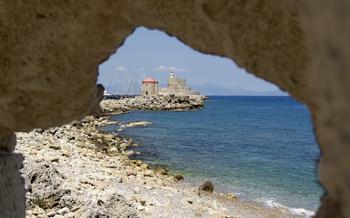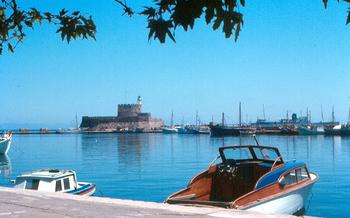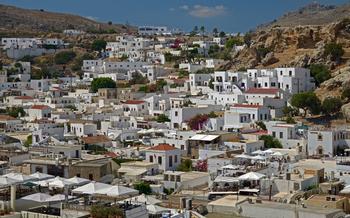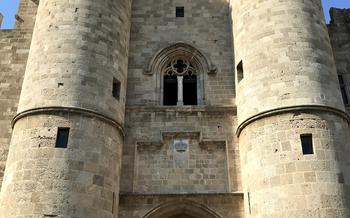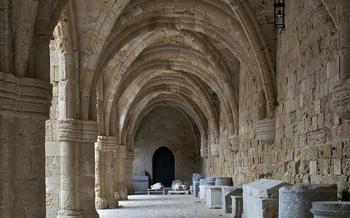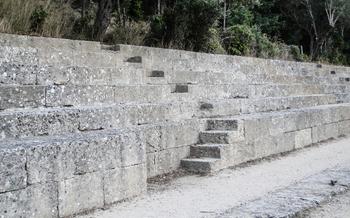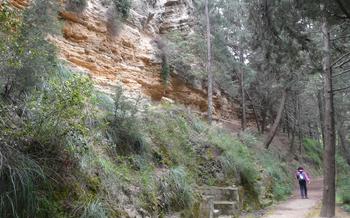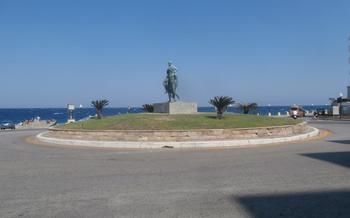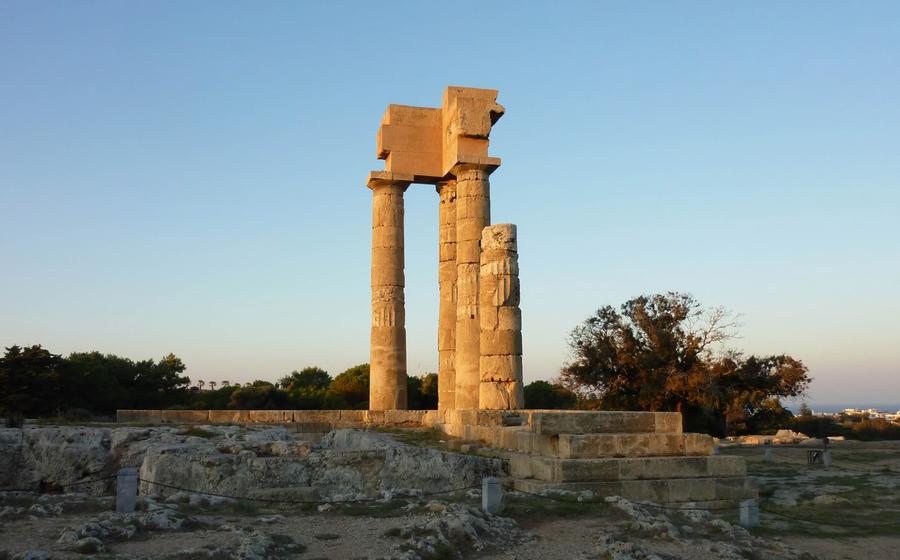
Temple of Apollo
- The Temple of Apollo: A Monumental Legacy
- Location and Accessibility
- Opening Hours and Admission Fees
- Exploring the Temple Grounds
- Historical Context and Significance
- Architectural Marvels
- Myths and Legends
- Preservation and Restoration
- Temple Rituals and Ceremonies
- The Temple's Impact on Modern Rhodes
- Photography Tips
- Educational Opportunities
- Nearby Attractions
- Local Cuisine and Dining Options
- Insider Tip: Hidden Gem
The Temple of Apollo: A Monumental Legacy
The Temple of Apollo, a testament to ancient Greek architecture and religious devotion, stands as a symbol of Rhodes' rich history and cultural heritage. Built in the 3rd century BC, the temple was dedicated to Apollo, the Olympian god of prophecy, music, and healing. Its imposing presence and intricate design have made it one of the most significant landmarks on the island and a must-visit destination for anyone interested in ancient Greece.
The temple's construction showcases the architectural prowess of the ancient Greeks. Utilizing the distinctive Doric style, characterized by its simple yet powerful lines, the temple features grand columns, intricate pediments, and beautifully sculpted bas-reliefs. Its well-preserved state, thanks to ongoing restoration efforts, allows visitors to admire the temple's original grandeur and appreciate the craftsmanship of its builders.
Beyond its architectural significance, the Temple of Apollo holds deep symbolic and mythological meanings. As the protector of Rhodes, Apollo was revered by the island's inhabitants, and the temple served as a place of worship and pilgrimage. The temple's association with Apollo and other deities has contributed to its enduring legacy and made it a site of great religious and spiritual importance.
Location and Accessibility
The Temple of Apollo is situated in the ancient city of Ialyssos, a picturesque town located approximately 8 kilometers southwest of Rhodes Town. To reach the temple, you can either take a leisurely stroll along the scenic coastal road or hop on a local bus that departs from the city center. Once you arrive in Ialyssos, follow the signs leading to the Akropolis, where the temple is majestically perched.
For those arriving by car, there is a designated parking area near the entrance of the archaeological site. It's important to note that the temple is situated on a hilltop, so be prepared for a short but rewarding climb to reach its summit. The effort will be well worth it once you witness the awe-inspiring views of the surrounding countryside and the sparkling Aegean Sea.
In addition to the Temple of Apollo, the Akropolis of Ialyssos is home to several other significant ancient ruins, including the Sanctuary of Athena Polias and the Ancient Stadium. By visiting this archaeological complex, you'll have the opportunity to immerse yourself in the rich history and culture of ancient Rhodes.
Opening Hours and Admission Fees
The Temple of Apollo welcomes visitors from Tuesday to Sunday, with slightly different operating hours depending on the season. During the summer months (April to October), the temple is open from 8:00 AM to 8:00 PM, allowing ample time to explore its grounds and admire its majestic presence. In the winter season (November to March), the opening hours are slightly shorter, from 8:00 AM to 5:00 PM.
Regular admission tickets for adults cost €6, while students and seniors can benefit from a discounted rate of €3. Guided tours are also available at an additional cost, providing visitors with an in-depth exploration of the temple's history, architecture, and significance. To secure your spot on a guided tour, it is advisable to book in advance. Visitors can purchase tickets online or directly at the ticket office located near the temple's entrance.
Exploring the Temple Grounds
The Temple of Apollo stands as a testament to ancient Greek architecture and religious beliefs. As you approach the temple, take a moment to admire its imposing presence and the intricate details adorning its facade. The temple's layout is straightforward, with a rectangular courtyard surrounded by a colonnade of Doric columns. The courtyard leads to the cella, the innermost chamber of the temple, where the cult statue of Apollo once stood.
As you wander through the temple grounds, don't miss the key highlights that showcase the temple's grandeur. The grand columns, each standing tall and majestic, support the pediments adorned with intricate sculptures depicting mythological scenes. Look out for the well-preserved bas-reliefs on the temple walls, which offer a glimpse into ancient Greek mythology and religious beliefs.
Take advantage of the photo opportunities the temple offers. Capture the temple's imposing facade against the backdrop of the clear blue sky. Experiment with different angles to capture the intricate details of the columns and sculptures. Don't forget to immortalize the temple's grandeur with a panoramic shot that encompasses its majestic presence.
A thorough visit to the Temple of Apollo requires around an hour. Take your time to explore the temple grounds, admire the architectural marvels, and soak up the historical significance of this ancient sanctuary. Let the temple transport you back in time, evoking the grandeur and spirituality of ancient Greece.
Historical Context and Significance
The Temple of Apollo holds immense historical significance as a testament to ancient Greek culture and religious practices. Built in the 3rd century BC, it served as a sacred site dedicated to the worship of Apollo, the Greek god of light, music, and prophecy. The temple was a central location for religious ceremonies and rituals, where devotees would gather to offer prayers, sacrifices, and seek guidance from the oracle of Apollo.
The temple's construction was commissioned by the Rhodian people, who held Apollo in high esteem. They believed that the god played a crucial role in guiding and protecting their island. The temple's design and grandeur reflected the importance of Apollo in their lives, as well as their commitment to honoring the gods.
The temple's religious significance extended beyond Rhodes. It was known throughout the ancient world as a center of pilgrimage and worship. People from distant lands would travel to Rhodes to seek answers from the oracle, to participate in religious festivals, or simply to pay homage to Apollo.
The temple also served as a place of refuge and sanctuary. Those seeking protection or asylum would often flock to the temple grounds, where they would be granted safe passage and sanctuary. This tradition of offering sanctuary was a testament to the temple's sacred and inviolable status.
The Temple of Apollo stood as a symbol of religious devotion, cultural identity, and the deep connection between the Rhodian people and their gods. Its legacy continues to this day, as it remains one of the most significant and well-preserved ancient Greek temples in the world.
Architectural Marvels
The Temple of Apollo showcases the distinctive features of the Doric architectural style. The grand columns, towering over the surrounding landscape, are adorned with intricate flutes, creating a harmonious rhythm and a sense of strength. The pediments, triangular in shape, display beautifully sculpted mythological scenes and figures, adding narrative depth to the temple's facade.
Intricate sculptures and bas-reliefs adorn the temple's walls, depicting various deities, heroes, and mythological creatures. These intricate carvings provide a glimpse into the artistic prowess of ancient Greek craftsmen and offer valuable insights into the religious beliefs and practices of the time.
The Temple of Apollo stands as a testament to the architectural brilliance of ancient Greece. Its Doric design, with its fluted columns, sculpted pediments, and intricate bas-reliefs, epitomizes the harmony, precision, and grandeur that characterized Greek architecture. Comparing it to other iconic Greek temples, such as the Parthenon in Athens, reveals the unique characteristics and contributions of the Temple of Apollo to the rich architectural heritage of Greece.
Myths and Legends
The Temple of Apollo is steeped in a rich tapestry of myths and legends that have captivated imaginations for centuries. According to Greek mythology, Apollo, the radiant god of the sun, music, and prophecy, had a special connection to the island of Rhodes. It is said that he was born here, or at least spent a significant part of his childhood, instilling the island with his divine presence.
One of the most intriguing tales associated with the temple is the myth of the Telchines, a race of mischievous sea creatures with magical abilities. Legend has it that they were the original inhabitants of Rhodes and possessed the power to transform themselves into various shapes. However, due to their malicious nature, Zeus, the king of the gods, banished them from the island.
Another captivating legend tells of the temple's construction. It is said that Apollo himself commanded the Telchines to build a magnificent temple in his honor. However, due to their cunning nature, they created a structure that was intentionally unstable and prone to collapse. Apollo, angered by their deceit, cursed the Telchines, causing them to turn into stone.
These myths and legends add an enchanting layer to the allure of the Temple of Apollo. They transport visitors back in time, allowing them to glimpse into the vibrant world of ancient Greek mythology and the sacred significance of this remarkable sanctuary.
Preservation and Restoration
The Temple of Apollo has undergone extensive restoration efforts throughout history, ensuring its preservation for future generations. In the early 20th century, Italian archaeologists conducted significant excavations and restoration work, uncovering many valuable artifacts and stabilizing the temple's structure. These efforts laid the foundation for ongoing preservation initiatives.
Modern restoration techniques focus on preserving the temple's original materials and features while addressing the effects of time and natural elements. Conservationists employ specialized methods to clean and repair the temple's columns, pediments, and sculptures, using materials that are compatible with the original construction.
One of the key challenges in preserving the temple is the ongoing threat of erosion caused by wind, rain, and salt spray from the nearby sea. Protective measures, such as water-resistant coatings and regular maintenance, are implemented to mitigate these effects.
Despite the challenges, the Temple of Apollo stands as a testament to the dedication and expertise of those committed to its preservation. The ongoing efforts ensure that this ancient marvel continues to captivate and inspire visitors from around the world.
Temple Rituals and Ceremonies
In ancient times, the Temple of Apollo was a vibrant center of religious ceremonies and rituals. Devotees from across Rhodes and beyond would gather here to honor the sun god and seek his favor. The temple's priests and priestesses played a crucial role in conducting these sacred rites.
The most common ritual performed at the temple was the offering of sacrifices. Animals such as bulls, goats, and sheep were brought to the temple and sacrificed on the altar in front of the temple's colossal statue of Apollo. These offerings were a way for worshippers to express their gratitude to the god and to seek his protection.
In addition to animal sacrifices, the temple also hosted a variety of other rituals and ceremonies. These included processions, prayers, and libations (the pouring of liquid offerings onto the ground). The temple was also a place of divination, where people could seek guidance from Apollo through oracles and other forms of divination.
The festivals held at the Temple of Apollo were particularly grand and elaborate. The most important of these was the Rhodian Festival, which was celebrated every four years. During the festival, people from all over the island would come to Rhodes to participate in a series of games, competitions, and religious ceremonies. The festival was a time of great joy and celebration, and it was an opportunity for people to come together and honor their patron god.
The Temple's Impact on Modern Rhodes
The Temple of Apollo stands as a testament to Rhodes' rich heritage and cultural significance. Its imposing presence and historical allure have made it a symbol of the island, deeply intertwined with the local identity and traditions. The temple's enduring legacy has shaped Rhodes' cultural landscape, influencing everything from local cuisine and festivals to art, literature, and music.
Tourism plays a vital role in preserving and promoting the temple's significance. Visitors from around the world flock to Rhodes to marvel at this ancient wonder, eager to learn about its history and mythology. The temple's status as a UNESCO World Heritage Site further enhances its appeal and attracts visitors interested in experiencing the island's cultural treasures.
Efforts to promote the temple's importance extend beyond tourism. Local authorities and cultural organizations work tirelessly to raise awareness about the temple's history, symbolism, and architectural significance. Educational programs, workshops, and lectures are organized to engage both locals and visitors, fostering a deeper appreciation for Rhodes' ancient past.
The Temple of Apollo is not merely a relic of the past but an active and vibrant part of modern Rhodes. Its presence continues to inspire awe and wonder, serving as a reminder of the island's rich cultural heritage and its enduring connection to the ancient world.
Photography Tips
Capturing the essence of the Temple of Apollo through photography is a rewarding experience. Here are some tips to help you make the most of your photographic journey:
-
Golden Hour Magic: Plan your visit during the golden hours, just after sunrise or before sunset, when the warm, diffused light casts a magical glow on the temple's ruins, creating stunning photo opportunities.
-
Camera Settings: Opt for a wide-angle lens to capture the temple's grandeur and scale. Use a tripod for stability, especially when shooting in low-light conditions, to avoid camera shake and ensure sharp images.
-
Creative Perspectives: Experiment with different angles and vantage points. Climb the nearby hills for an elevated perspective, or get down low to capture the temple's imposing columns from a unique angle.
-
Details and Textures: Don't just focus on the temple as a whole; zoom in on the intricate carvings, sculptures, and textures that adorn its walls and columns. These details add depth and character to your photographs.
Educational Opportunities
The Temple of Apollo is not just a historical site but also a treasure trove of knowledge and inspiration. On-site information panels provide detailed explanations about the temple's history, architecture, and significance. Visitors can also take advantage of guided tours led by experienced historians and archaeologists who bring the ancient world to life with their captivating narratives.
For those seeking a deeper dive into the temple's legacy, educational programs for schools and groups are available. These programs offer interactive experiences that allow participants to learn about ancient Greek history, mythology, and culture through hands-on activities, workshops, and lectures.
The temple also plays a crucial role in archaeological research and excavations. Scholars from around the world come to Rhodes to study the temple and its surroundings, uncovering new insights into the ancient civilization that built it. Visitors can witness these excavations firsthand and gain a glimpse into the ongoing process of archaeological discovery.
Nearby Attractions
In the vicinity of the Temple of Apollo, there's a treasure trove of other ancient wonders waiting to be explored. Just a stone's throw away lies the Acropolis of Rhodes, a fortified citadel that once served as the city's administrative and religious center. Within its walls, you'll find the remains of ancient temples, theaters, and public buildings, offering a glimpse into the city's glorious past.
A short walk from the temple, you'll stumble upon the Ancient Stadium of Rhodes, a well-preserved sporting arena that hosted athletic competitions and chariot races in ancient times. Imagine the roar of the crowd as athletes competed for glory and honor in this magnificent setting.
History buffs will delight in the Archaeological Museum of Rhodes, which houses an impressive collection of artifacts unearthed from the island's rich past. From ancient sculptures and pottery to intricate mosaics and jewelry, the museum provides a fascinating journey through Rhodes' diverse cultural heritage.
And for a taste of medieval grandeur, pay a visit to the imposing Grand Master's Palace, once the residence of the Knights of St. John. Admire its Gothic architecture, explore its grand halls and chambers, and learn about the fascinating history of the Knights Hospitaller.
Local Cuisine and Dining Options
Rhodes is renowned for its delectable cuisine, a blend of Greek and Mediterranean flavors. While visiting the Temple of Apollo, take the opportunity to savor the local culinary delights. Indulge in traditional dishes such as moussaka, a flavorful eggplant and minced meat casserole, or souvlaki, succulent grilled skewers of meat or fish. For seafood enthusiasts, Rhodes offers an array of freshly caught delicacies like grilled octopus or fried calamari.
For an authentic dining experience, venture into the narrow streets surrounding the temple, where you'll find charming tavernas and restaurants. Sample the local meze platters, an assortment of small dishes featuring cheeses, olives, dips, and grilled vegetables. Don't miss the chance to try the local wines, especially the white variety produced from the indigenous Athiri grape.
To immerse yourself in the local culture, visit the central market, a vibrant hub where you can shop for fresh produce, spices, and souvenirs. Engage with the friendly vendors and learn about the island's culinary traditions. Whether you choose to dine at a traditional taverna or enjoy a picnic amidst the ancient ruins, Rhodes offers a feast for both the eyes and the palate.
Insider Tip: Hidden Gem
Beyond the temple's grandeur, Rhodes holds a secret spot that offers a unique perspective. Nestled amidst olive groves and fragrant pine trees, a secluded hilltop unveils breathtaking vistas of the ancient ruins. This hidden gem, known as Moni Skiadi, is a former monastery that has been transformed into a tranquil retreat.
The path leading to the hilltop is adorned with wildflowers and the gentle chirping of birds. As you ascend, the temple's majestic silhouette emerges, framed by the azure sky and the shimmering Mediterranean Sea. The panoramic views from the monastery's terrace are simply mesmerizing.
For a truly serene experience, visit Moni Skiadi early in the morning or late in the afternoon, when the soft golden light casts a magical glow upon the landscape. You can even pack a picnic lunch and savor a delightful meal amidst the tranquil surroundings.
To reach this hidden gem, follow the road that leads from the temple towards the village of Apollona. Take a left turn at the sign for Moni Skiadi and follow the winding path for approximately 2 kilometers. The monastery's entrance will be on your left.
Unveiling the secrets of Rhodes is part of the adventure. Embrace the opportunity to discover this hidden gem and create lasting memories of your journey through this enchanting island.
